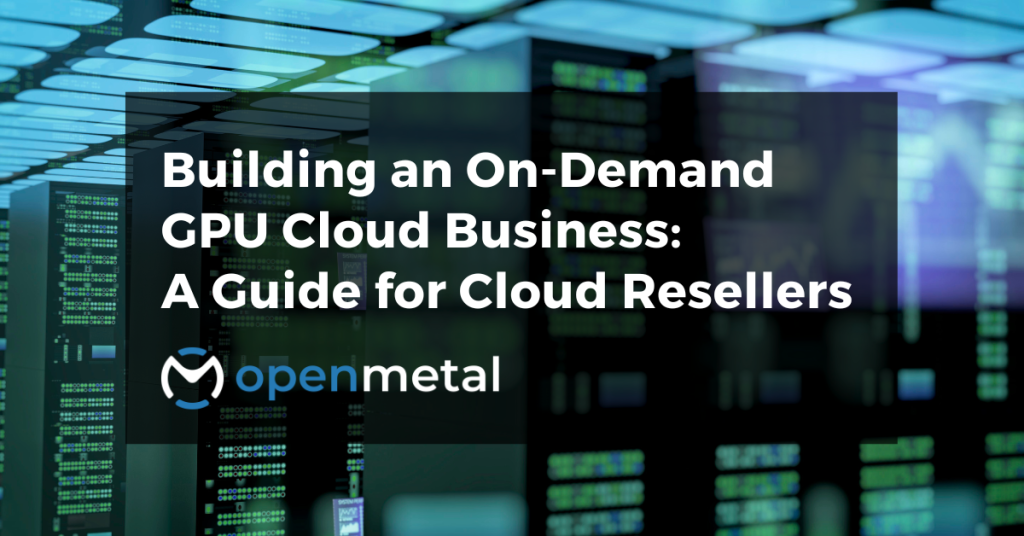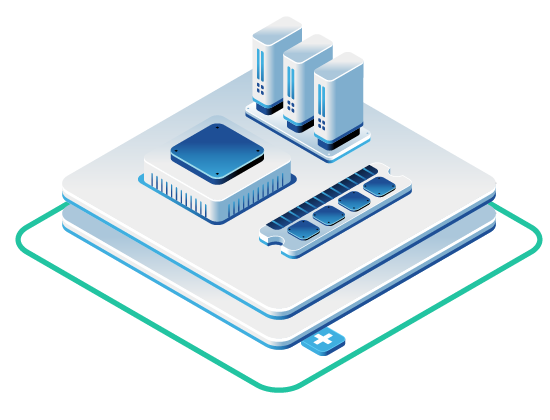
Cloud resellers are uniquely positioned to meet the booming demand for GPU-accelerated services. By leveraging OpenMetal’s Private GPU Servers and Clusters, resellers can offer on-demand GPU instances to their own customers with full control, transparent costs, and high performance.
This article explores a use case scenario where a reseller purchases dedicated GPU hardware from OpenMetal and uses time slicing and virtualization to carve it into flexible, on-demand GPU offerings.
We’ll dive into the technical approaches (like NVIDIA’s Multi-Instance GPU and time-sliced sharing) that maximize GPU utilization, and we’ll highlight how OpenMetal’s infrastructure enables secure multi-tenant GPU sharing for AI/ML workloads. In addition, we’ll briefly touch on other GPU-powered applications – from 3D rendering and virtual desktops to cloud gaming – showing the broad business opportunities available. Let’s explore how you can build a profitable, efficient GPU cloud service on top of OpenMetal’s platform.
The Explosive Growth of the GPU Market for AI/ML
The market for GPUs, especially for AI/ML workloads, is experiencing unprecedented growth.
- According to Grand View Research, the global artificial intelligence market size was valued at USD 279.22 billion in 2024 and is projected to grow at a CAGR of 35.9% from 2025 to 2030, driven largely by the increasing need for high-performance computing infrastructure.
- In parallel, the global GPU market is projected to reach over $400 billion by 2032, up from $47.5 billion in 2022, according to Precedence Research. A significant portion of this growth is attributed to AI training and inference, as well as emerging workloads like generative AI and LLMs.
Enterprise spending on infrastructure is rapidly shifting toward private deployments, due to concerns about data control, performance predictability, and escalating public cloud costs. This creates a unique opportunity for cloud resellers to step in with GPU-powered private cloud offerings that blend cost-efficiency with control and flexibility.
“We’re seeing a new wave of innovation from smaller providers who can outmaneuver the big clouds by offering direct access to high-performance GPU infrastructure,” says Todd Robinson, Co-Founder of OpenMetal. “Resellers who tap into this wave can build profitable businesses on top of our platform while giving their customers a better experience.”
Why Resell Private GPUs for On-Demand Services?
The surge in AI and graphics-intensive applications has made GPU resources incredibly valuable – but also expensive if left underutilized. As a cloud reseller, investing in private GPU servers can unlock new revenue streams. Instead of subleasing generic public cloud GPUs (with premium pricing and throttled performance), you can own dedicated hardware and virtualize it into smaller units. This means you control the environment end-to-end: no “noisy neighbor” from unknown tenants to degrade performance, and no surprises in cost or resource limits.
By offering fractional GPU instances on-demand, you cater to a wider range of customers – from startups needing a few GPU hours for model training to enterprises requiring steady GPU power for VDI or rendering. Ultimately, reselling private GPUs with on-demand flexibility lets you capture the growing AI/ML market while maintaining predictable costs and high utilization of your hardware. Here are some key business reasons for this model:
High Demand, Fine-Grained Supply
AI developers, researchers, and creatives often need GPUs in varying amounts. By slicing a physical GPU into multiple virtual GPUs, you can serve many customers concurrently, maximizing hardware ROI.
Competitive Pricing Models
Owning the GPU outright (via OpenMetal’s fixed monthly pricing) allows you to create flexible pricing for your customers – for example, hourly rates for a 1/7th GPU slice or discounted monthly plans for dedicated GPU portions. This granularity is hard to achieve without virtualization.
Quality of Service Control
With your own GPU server, you set the rules. There’s no cloud vendor silently time-slicing your GPU or capping its clock speed due to someone else’s workload. You decide how to allocate GPU cycles, ensuring priority clients get consistent performance.
Customer Trust and Data Security
Some clients (in healthcare, finance, etc.) hesitate to use public, multi-tenant clouds for sensitive workloads. By offering GPU capacity on a single-tenant private cloud (yours), you can promise greater data isolation and compliance. OpenMetal’s infrastructure gives you complete control with no compromises on privacy – a strong selling point for regulated industries.
Questions? Schedule a meeting
GPU Sharing Technologies: Time-Slicing vs. Multi-Instance GPU (MIG)
To build an on-demand GPU service, resellers need to split or share GPUs among multiple end-users. Two primary technologies make this possible on OpenMetal’s NVIDIA-based servers: time-slicing and Multi-Instance GPU (MIG). Both approaches let you virtualize a single physical GPU into multiple logical units, but they work differently:
Multi-Instance GPU (MIG)
A feature introduced with NVIDIA’s Ampere architecture (e.g., A100 GPUs), MIG allows hardware partitioning of a GPU into as many as seven isolated instances. Each MIG instance behaves like a smaller independent GPU with its own dedicated compute cores, high-bandwidth memory, and cache. Fault and memory isolation is a major advantage – one tenant’s workload on a MIG slice cannot interfere with another’s performance or data. For example, on an NVIDIA A100 (40GB GPU), you might partition it into 7 MIG instances of 1g.5gb each (each with 5GB memory), or 2 instances of 3g.20gb (20GB memory each), depending on the workload and isolation needs. Note that the full 40GB isn’t available for MIG instances—a portion is reserved for system use. MIG is ideal when you need predictable performance and strong isolation (as in multi-tenant AI inference platforms). It’s supported on NVIDIA A100, H100, and newer GPUs, and integrates with virtualization platforms like OpenStack and Kubernetes.
Time-Slicing
Time-slicing is a software-based GPU sharing technique that schedules multiple workloads on one GPU in rapid succession. Instead of dividing the GPU’s hardware into fixed chunks, each job gets the full GPU for a brief timeslice (a fraction of a second) before yielding to the next job, in a round-robin fashion. This approach enables a higher number of users or processes to share a GPU (high user density) since you’re not limited by a fixed instance count. Time-slicing shines for bursty or lower-priority tasks where absolute consistency isn’t critical. It also works on older GPU models that don’t support MIG. However, because all time-sliced tasks share the same memory and core, isolation is limited – heavy use by one job can slow others, and memory is a shared pool. In practice, time-slicing is useful for oversubscribing a GPU with many small workloads (like dozens of short inference requests or student labs) to maximize utilization when minor performance variability is acceptable.
Both methods can even be combined for maximum effect. MIG and time-slicing are not mutually exclusive – you could partition a GPU into a few MIG instances (ensuring groups of users are isolated) and then run a time-slicing scheduler within each instance to serve multiple jobs per slice. For example, in a Kubernetes cluster, you might allocate a MIG slice per namespace, and within each slice the NVIDIA GPU Operator time-shares jobs from that namespace. This hybrid approach balances performance with cost efficiency: MIG gives each tenant a baseline guarantee, while time-slicing squeezes in extra workloads to use idle cycles.
OpenMetal’s infrastructure supports both MIG and time-slicing configurations in its private cloud environments. This is a notable differentiator – many providers offer MIG or simple vGPU partitioning, but few support true time-sliced sharing on dedicated GPUs. As a reseller, having access to both options means you can tailor your GPU product to your customers’ needs: offer MIG-backed “dedicated GPU slices” for high-priority users and a time-shared pool for cheaper, general-purpose GPU access. We’ll next look at how to put these techniques into action for maximizing utilization and enabling flexible pricing.
Questions? Schedule a meeting
Maximizing GPU Utilization with Virtualization
One of the biggest advantages of virtualizing GPUs (via MIG, vGPU, or time-slicing) is the ability to fully utilize expensive hardware. A high-end GPU like the NVIDIA H100 or A100 has tremendous computing power – far more than many single tasks can use. Instead of letting that capacity go to waste when a workload isn’t using 100% of the GPU, resellers can allocate the spare horsepower to others. This is how on-demand cloud giants operate, and you can do it on your own terms with OpenMetal’s private gear. The following describes how virtualization boosts utilization and ROI:
Multiple Tenants on One GPU
With MIG partitioning, an A100 GPU can be split into up to seven separate GPU instances. Note that a small part of the GPU is always reserved for system use. That means up to seven different customers (or seven separate VM instances) could be running tasks on a single physical GPU concurrently, each getting guaranteed resources. If each of those tasks only needed, say, 10-20% of a full GPU, sharing the device ensures the silicon is busy nearly 100% of the time. Without sharing, you might have had one customer’s job using 20% and 80% of the GPU would sit idle (earning you nothing). MIG’s hardware partitioning ensures these customers don’t contend with each other, delivering full performance to each slice while dramatically improving overall utilization.
Overcommitting with Time-Slicing
Time-slicing allows careful over-subscription of GPU resources. For instance, you could offer 10 “virtual GPU” instances backed by one physical GPU. At any given moment, only one instance actually executes on the GPU (so tasks take turns rapidly), but if those tasks often wait on I/O or aren’t continuously heavy, the switching makes sure no GPU time is wasted idle. This is especially useful for interactive or bursty workloads – e.g., ten developers tinkering with smaller models or graphics sessions. Each gets the feeling of having GPU access when needed, but you as the provider achieve far higher utilization than dedicating a full GPU per user. In cloud terms, you’re selling the same asset to multiple clients in slices of time. Throughput can be maximized by filling in GPU idle gaps with other tasks. Of course, you would monitor usage to avoid severe contention – e.g., limit the number of heavy jobs that run simultaneously or use scheduling policies to prioritize. The end result is efficient GPU cycles use: nearly every clock cycle is doing work (and generating revenue).
Dynamic Workload Balancing
Because virtualization adds a layer of abstraction, you can dynamically reallocate resources based on demand. Suppose during the day you have many users needing small GPU fractions (e.g., for inference or VDI sessions). At night, one customer wants to run a large model training across the whole GPU. With OpenMetal’s platform, you could in principle reconfigure MIG instances on the fly – run seven small MIG slices for daytime concurrency, then consolidate into one big MIG at night for that training job. This agility means your hardware adapts to workload patterns, further ensuring no capacity sits idle beyond necessity. Time-slicing is inherently dynamic as well: if five of the ten time-shared tasks finish, the remaining five simply get larger time slices each – effectively those users see improved performance without any manual intervention.
In practice, achieving high utilization requires thoughtful capacity planning. MIG guarantees each partition’s share, so you typically won’t overcommit beyond the physical GPU’s limits (e.g., no more than 7 MIG instances on an A100 because of hardware constraints). Time-slicing, on the other hand, should be tuned: you might allow more contexts than MIG would, but with an eye on performance. Tools like NVIDIA’s Kubernetes GPU scheduler or OpenStack’s scheduling filters let you define how many vGPUs can map onto one GPU. The key is to strike a balance where the GPU is busy enough to justify its cost, but not so oversubscribed that customers experience unacceptable slowdowns. OpenMetal’s support team can assist with finding that balance, as their engineers help clients “ensure you’re maximizing the value of your services” on the hardware.
Questions? Schedule a meeting
Flexible Pricing Models Enabled by Fractional GPUs
Once your GPU resources are virtualized and shareable, you unlock the ability to create innovative pricing models for your customers. Rather than renting out a whole physical GPU at a fixed high price, you can offer smaller units of GPU power at various price points. Here’s how resellers can craft flexible pricing using time-slicing and virtualization:
Pay-Per-Use (On-Demand Pricing)
Much like public clouds, you can charge by the hour or minute for GPU usage. For example, with time-slicing, if a customer’s container or VM runs on the GPU for 30 seconds, you could bill for 0.5 GPU-minutes. This granular billing is appealing to developers who just need quick bursts of GPU for testing or inference. Because your cost is fixed (you pay OpenMetal a flat monthly rate for the server), any time the GPU is in use by a paying customer contributes to your revenue. The more you keep it busy across tenants, the more you profit.
Fractional GPU Instances at Tiered Rates
Using MIG or virtual GPUs, you can define “instance sizes” – You can offer standard MIG profiles such as 1g.5gb (small), 2g.10gb (medium), or 3g.20gb (large). Pricing tiers can map directly to these defined NVIDIA partitions. Customers with lighter needs can opt for the cheaper small instance, while those requiring more VRAM or compute can pay more for a larger slice. All the while, these are running on the same physical card. This tiered approach broadens your market: you’re not excluding clients who find full GPUs too costly, yet you still capture high-end demand by offering bigger slices. NVIDIA’s MIG makes this feasible by ensuring each slice gets dedicated memory and cores, giving quality of service (QoS) assurances even for the small slices. As NVIDIA notes, MIG allows right-sizing GPU instances for each workload, ultimately optimizing utilization and maximizing data center investment – which directly translates to better margins on your GPU hardware.
Subscription or Reserved Models
Not all customers want pure pay-as-you-go. Some might want a guaranteed chunk of GPU available 24/7 for a month. You could use MIG to allocate, say, a quarter of a GPU to a client’s virtual machine and offer it as a monthly subscription (“Dedicated 25% of an H100 for $X/month”). Since MIG partitions are persistent and isolated, that client effectively has a mini-GPU reserved. You ensure they get steady performance, and in return you get a predictable monthly fee. Meanwhile, your remaining GPU capacity can be sold on-demand to others. This mix of reserved and on-demand pricing lets you secure baseline revenue while still maximizing any unused cycles via time-sliced sharing for additional pay-per-use income.
Burst Pricing or Credits
You could implement a model where each customer buys a certain amount of “GPU credits” per month (for example, 100 hours of GPU time). These credits could be consumed in any increment (thanks to time-slicing) whenever the user runs jobs. If they exceed the included amount, they pay an overage fee or move to the on-demand rate. This is similar to how some cloud providers offer burstable instances. The virtualization layer tracks usage per tenant, making it feasible to meter such consumption precisely.
From a business perspective, these flexible models are enabled by the technical capability to split a GPU securely. MIG’s strict isolation guarantees that a high-paying customer on a reserved slice isn’t impacted by a lower-tier neighbor. Meanwhile, your budget-conscious users on a shared GPU know they’re paying less in exchange for a possible slight delay (since time-slicing is best-effort and can have variable latency under load). With clear communication and proper SLAs for each tier, you can align pricing to the level of performance and isolation each client requires.
Questions? Schedule a meeting
Implementing Secure Multi-Tenancy on OpenMetal
A crucial requirement when sharing GPUs among multiple customers is ensuring security and isolation. No client wants their data or models leaking to another, and everyone expects fair performance. OpenMetal’s platform is designed with these concerns in mind, offering technologies to keep multi-tenant environments both secure and efficient:
Hardware-Level Isolation with MIG
As described, MIG creates isolated GPU instances at the hardware level. Each instance has its own dedicated framebuffer memory and compute slices, so one tenant cannot read or overwrite another tenant’s GPU memory. This is critical for multi-tenant AI workloads – sensitive data batches stay within the assigned MIG partition. Fault isolation is also important: if one user’s code crashes their GPU context or runs into a memory error, it won’t stall the whole GPU or affect others. For cloud resellers, this means you can confidently host different customers (even competitors or those with strict compliance needs) on the same physical GPU with minimal risk of cross-talk. Essentially, MIG enables secure multi-tenant GPU sharing akin to how VMs enable multi-tenant CPU/RAM sharing.
OpenStack Integration and vGPU Management
OpenMetal’s GPU clusters can integrate with OpenStack – a cloud operating system that manages virtual machines and resources. Using OpenStack Nova (the compute service), you can expose MIG instances or vGPU devices to tenant VMs with fine-grained control.
For example, you can create custom flavors in OpenStack that represent a certain GPU share (like a flavor with resources:VGPU=1 might correspond to one MIG 1g.5gb instance). When a tenant boots a VM with that flavor, Nova will allocate a virtual GPU device attached to the physical GPU accordingly. This process uses mediated passthrough (mdev) under the hood to safely share the GPU. The benefit is twofold:
- From a security standpoint, OpenStack will enforce isolation – each vGPU device (backed by MIG or time-slice context) is mapped to only that VM. The hypervisor and NVIDIA’s drivers ensure that one VM cannot intrude into another’s GPU memory space.
- From a usability standpoint, your customers can provision GPU-enabled VMs on-demand through a self-service portal or API, just like they would request a normal VM. They don’t need to know the details of MIG or time-slicing; they simply choose a “GPU-small” or “GPU-large” flavor. This aligns perfectly with the on-demand cloud experience. Meanwhile, you, as the cloud operator, can monitor and limit how these are scheduled to prevent any single GPU from being oversubscribed beyond what you intend.
Secure Multi-Tenancy in Kubernetes
If your service is container-based or if you offer Kubernetes clusters on your cloud, you can similarly enforce multi-tenant GPU sharing there. NVIDIA’s GPU Operator and Kubernetes device plugins can be configured to either partition via MIG or use time-slicing to share GPUs among pods. By using Kubernetes Namespaces or tenant-specific node pools, you isolate users at the software level, and with MIG you isolate at hardware level too. For example, you might dedicate a MIG slice per namespace (ensuring one team’s pods only use their slice). Additionally, Linux and NVIDIA drivers have security measures for time-slicing contexts. Although time-slicing doesn’t give memory isolation, the CUDA context separation means one process can’t directly read another’s data unless there’s a driver bug – and such bugs are rare and quickly patched. Still, if absolute security is required, you’d steer those clients toward a MIG slice or a whole GPU. OpenMetal gives you the flexibility to do either within one environment.
Networking and Storage Isolation
Beyond the GPU itself, OpenMetal’s private cloud setup isolates networking and storage per tenant project (using VLANs, VXLANs, tenant-specific Ceph pools, etc.). So multi-tenancy security isn’t just at the GPU level – the entire stack is built for secure separation. This allows you to confidently serve multiple customers on the same physical cluster. In effect, you’re operating like a mini-public cloud, but with the enhanced security of a private cloud, since all hardware is single-tenant to you (the reseller) and you decide how to securely subdivide it for your users.
To sum up, OpenMetal’s technical capabilities (MIG, SR-IOV for full GPU passthrough, OpenStack support, etc.) empower secure GPU sharing. You get the best of both worlds: high utilization from sharing, with isolation features to keep workloads safe and performant. The next section will illustrate a practical example of how a reseller can put these pieces together for an AI/ML use case.
Questions? Schedule a meeting
Example Use Case: On-Demand AI/ML Lab for Multiple Clients
Imagine you’re a cloud reseller setting up a service called “AI Lab Cloud,” where universities, startups, or enterprise R&D teams can rent GPU-powered environments on demand. Here’s how you might execute this model using OpenMetal’s infrastructure:
- Acquire Private GPU Servers
You start by provisioning an OpenMetal GPU cluster with, say, 2 nodes, each containing 4× NVIDIA A100 GPUs. These are delivered as bare metal, and you have full root access to install software or hypervisors of your choice. The hardware is dedicated to you alone, so you’re free to enable any GPU sharing features (MIG mode, etc.) without competing with other tenants at the hardware level. - Deploy an OpenStack-powered cloud on OpenMetal
To provide on-demand provisioning to your end-users, you use OpenMetal’s automated private cloud deployment. Within a short time, you have an private cloud powered by OpenStack up and running, integrated with your GPU servers. This gives you a “cloud within a cloud” – you can define projects, users, flavors (instance types), and those users can spin up VMs through a dashboard or API. If you prefer containers, you could alternatively deploy a Kubernetes cluster across those GPU nodes. For this example, let’s continue with OpenStack since it offers multi-tenant constructs out-of-the-box. - Enable GPU Virtualization
On each GPU node, you configure NVIDIA’s MIG mode and/or vGPU time-slicing:- Using nvidia-smi, you enable MIG mode on the A100s and create MIG partitions that suit your offerings (e.g., create two 3g.20gb instances and one 1g.5gb instance on each GPU – this is just an example splitting of memory and cores). Now each A100 has three “chunks” available: two medium slices and one small slice, each appearing as a separate GPU device to the system.
- In OpenStack Nova’s config, you map these MIG instances to Nova flavors. For instance, define a flavor “gpu.medium” that requests a mediated device of type A100-3g.20gb and a flavor “gpu.small” for the A100-1g.5gb. Nova will schedule VMs with those flavors onto the hosts and attach the appropriate vGPU (MIG device) to the VM.
- Additionally, you decide to allow some time-sharing on the smallest MIG instance: the “gpu.small” (5GB slice) might be further time-sliced for multiple lightweight jobs. This could be done by running multiple VMs on that same MIG device (Nova can schedule more than one VM to a MIG if you treat it as oversubscribed) or by having a container orchestrator within a single VM do it. The implementation can vary, but the principle is that the 1g.5gb MIG is a shared pool for perhaps 3-4 users doing very light tasks like running inference on small models. This way even the MIG slice is not left idle – it’s multiplexed.
- Offer Self-Service GPU Instances
Now on your “AI Lab Cloud” portal (which could just be OpenStack Horizon rebranded), your customers see that they can launch, for example, a Jupyter notebook VM with a GPU. They have size options: maybe Small GPU (5GB), Medium GPU (20GB), or Full GPU (40GB, which might actually allocate a whole physical GPU or the largest MIG 7g.40gb profile). A data science student might choose a Small GPU instance for an interactive session to develop a model. A larger enterprise customer might spin up several Medium GPU instances to run parallel inferencing jobs. Thanks to the earlier setup, when these requests come in, OpenStack places them onto the GPU servers and gives each VM its portion of the GPU. The student’s Small instance might actually be sharing one physical GPU with two other Small instances via time-slicing – but she still gets the power of an A100 for short bursts, more than sufficient for learning or prototyping. The enterprise’s Medium instances each get a dedicated MIG slice, so their jobs run concurrently on the same GPU card without interference. - Secure and Manage the Environment
Each client’s VM is in a separate OpenStack project with its own networks. They only access their own storage and data. The GPUs are partitioned such that the student in Project A and the enterprise in Project B can’t impact each other – one is on a separate MIG instance entirely. Even if two students share a MIG via time-slicing, they are separated by VM boundaries and scheduling. Your cloud operations team monitors GPU utilization: if the Small GPU pool is getting crowded and causing wait times, you might allocate another MIG slice to the “shared pool” or spin up an additional GPU node from OpenMetal to add capacity. The on-demand scalability of OpenMetal’s service means you can grow your GPU cluster quickly if your business takes off, without long hardware procurement delays. - Billing and Upsell
At the end of the month, you gather usage data. Perhaps the student used 10 hours of the Small GPU (billed maybe at $0.50/hour), and the enterprise ran Medium GPUs for a total of 300 hours (billed at $2/hour each, for example). Because you have a clear mapping of which VM flavor was used and for how long, it’s straightforward to calculate charges. You might also notice the enterprise’s consistent use and approach them with a reserved instance offer: “We see you use ~2 medium GPUs worth of capacity continuously. How about reserving a dedicated GPU slice for a flat monthly price – it’ll save you money and guarantee resources for you?” This way, the flexibility in how you allocate GPUs (shared vs dedicated) becomes a sales advantage. Some customers will opt for cost-effective shared access, others will pay a premium for dedicated performance – and you can accommodate both on the same physical infrastructure.
- Acquire Private GPU Servers
This scenario illustrates how, using OpenMetal’s private GPU hardware plus the power of MIG and time-slicing, a reseller can create a mini cloud offering tailored to AI/ML users. You effectively become a cloud provider yourself, but without having to build a data center or GPU farm from scratch – OpenMetal supplies the raw infrastructure as-a-service. Your value-add is in how cleverly you partition and sell that GPU power to end clients. Next, let’s briefly look at other areas where such an approach can be applied, beyond AI/ML.
Questions? Schedule a meeting
Beyond AI: Other GPU Use Cases (Rendering, VDI, Gaming)
While AI and ML workloads are a primary driver for GPU services, cloud resellers shouldn’t overlook other lucrative use cases. By purchasing a private GPU cluster and slicing it for on-demand use, you can cater to a variety of markets:
Rendering and VFX
Studios and designers often need massive GPU power for rendering films, animations, or architectural models – but only at certain times (e.g., project deadlines). With a virtualized GPU cluster, you could offer a render farm service where artists spin up GPU instances when needed. A single physical GPU could render multiple smaller scenes in parallel via MIG, or devote itself to one big job at a time. The isolation ensures one customer’s rendering task (which might consume large memory) doesn’t interfere with another’s. You can bill per frame or per GPU-hour. The ability to burst render capacity on-demand is a huge win for studios that otherwise must either invest in costly hardware or use expensive public cloud GPU instances.
Virtual Desktop Infrastructure (VDI)
Companies that require high-end graphics for remote workers (such as 3D CAD engineers, video editors, or geospatial analysts) often implement VDI with GPU acceleration. As a reseller, you can provide hosted virtual workstations backed by fractional GPUs. For example, an engineering firm could rent 10 virtual desktops, each with a quarter GPU MIG slice, allowing their designers to use CAD and rendering software remotely with near-native performance. NVIDIA’s virtual GPU software (GRID) and OpenStack can facilitate this by assigning a vGPU to each VDI VM. The benefit of using time-slicing here is that if a user is idle or lightly using their desktop, the GPU time can be given to someone running a heavier task, maintaining efficiency. With vGPU technology, multiple VDI users share one GPU while still enjoying smooth graphics and compute acceleration. You can offer this as a subscription per desktop, tapping into industries like architecture, oil & gas, or media production that need GPU-backed VDI.
Cloud Gaming
Gaming-as-a-service is another burgeoning field – think of services that let you stream high-end PC games to any device. These require powerful GPUs in the cloud. A single GPU can often run several game sessions via virtualization (since not all games fully saturate a data center GPU’s capabilities). By employing time-slicing or vGPU, you could host maybe 4–8 concurrent gaming sessions on one GPU, depending on the game and settings. Each gamer’s session would be isolated in a VM or container, perhaps with a MIG partition if needed for stability. The fast context-switching of time-slicing can provide a responsive experience if configured properly. As a reseller, you might partner with a gaming company or launch your own local cloud gaming platform. Pricing could be per hour of gameplay. Given the popularity of gaming, this could open a large consumer market – and because you’re using OpenMetal’s private GPUs, you could potentially place your servers in specific regions (OpenMetal has multiple data centers) to reduce latency to your user base.
Scientific Computing and HPC
Outside of commercial realms, universities or research labs may need transient GPU resources for simulations, data analysis, or visualization. By offering partitioned GPUs, you allow researchers to run their MATLAB, TensorFlow, or simulation workloads in an on-demand fashion without waiting for a whole GPU node in a traditional cluster. For instance, seven researchers could each get a MIG slice of an A100 instead of queuing for a full GPU node one by one. This speeds up research throughput while optimizing hardware use. You could bill grants or departments for only the portion of GPU they used (which is often much easier for them to budget than buying their own $15k GPU that sits idle half the time).
Each of these use cases can be enabled on the same underlying GPU cluster by adjusting how you virtualize and allocate the GPUs. It demonstrates the versatility of an on-demand GPU offering – you can target multiple niches (AI, rendering, VDI, gaming, etc.) with essentially the same pool of hardware. Just as cloud CPUs can run a web server in one VM and a scientific computation in another, cloud GPUs can accelerate diverse workloads side by side. The key is isolating them properly and tuning the share schedule (MIG for firm isolation, time-slicing for flexible sharing) to meet the performance needs of each application.
Questions? Schedule a meeting
Business Benefits and Best Practices for Resellers
Launching an on-demand GPU service using OpenMetal’s private GPU infrastructure is not just a technical endeavor – it’s a strategic business move. Here are the major benefits and some best practices to ensure success:
Higher Margins through Resource Efficiency
By time-slicing and subdividing GPUs, you essentially resell the same hardware multiple times. This can significantly increase your revenue per dollar of hardware. For example, if you lease a GPU server from OpenMetal for a fixed price, and you manage to consistently run 4 customer workloads on each GPU, your income from that server (charging customers) could be 3-4× what it would be if you rented it as a whole unit to a single client. After covering the fixed cost, the additional usage is pure profit. The cost-efficiency of sharing GPUs (when done appropriately) allows you to offer lower prices to end-users than many public cloud GPU instances, while still keeping healthy margins.
Differentiation and Control
You can differentiate your service by emphasizing performance consistency and customizability. Unlike big public clouds that may obscure what’s happening under the hood, you can be transparent: for instance, telling customers, “Your GPU share is hardware-isolated via NVIDIA MIG for guaranteed performance” – a promise backed by OpenMetal’s support of these advanced features. If a client needs a special configuration (maybe a specific driver version or wants to run an unusual workload), having full control at the metal means you can accommodate it. This level of service and flexibility can set you apart from competitors who might just resell vanilla cloud instances.
Secure Tenancy as a Selling Point
We discussed security at length – turn that into a selling point. Ensure clients that their workloads will run on private, single-tenant hardware (no third-party interference), with multi-tenant separation at the GPU level if sharing with others. For organizations worried about sharing GPUs in a public cloud (due to data sensitivity), your offering becomes an attractive alternative. In proposals or marketing, highlight features like dedicated bare metal, GPU isolation (MIG), and strong tenant isolation via OpenStack, as these translate to compliance and peace of mind for customers.
Support and Expertise from OpenMetal
Even though you’re building your own service, you’re not on your own. OpenMetal’s engineers can act as an extension of your team. They can assist with initial setup (like enabling MIG mode, configuring OpenStack for vGPUs), troubleshooting performance issues, or planning capacity expansions. This means you don’t need a large in-house hardware team to start offering sophisticated GPU solutions – leverage the partnership. By quickly resolving technical kinks (e.g., tuning the time-slice scheduler or updating GPU drivers), you ensure your service reliability stays high, which keeps customers happy.
Best Practice – Start Small, Scale Out
It might be wise to begin with a smaller GPU setup and specific use case to nail down your model. For instance, start by targeting local AI startups with a few GPU slices for training models. Gather feedback on pricing, performance, and support. As demand grows, you can easily scale out by adding more GPU servers or even expanding to multi-city deployments if using OpenMetal’s various data centers. The on-demand nature of OpenMetal (they can deploy new private cloud hardware for you in minutes or hours) means you don’t have to over-invest upfront. Scale capacity in step with your customer base – an efficient use of capital.
Monitoring and Fair Usage Policies
Implement good monitoring to track GPU usage per tenant. This helps in two ways: billing accuracy and maintaining fairness. If one client’s jobs start monopolizing a time-shared GPU and starving others, you’d catch it via metrics (high GPU utilization for that one tenant) and can intervene, perhaps by moving them to a dedicated MIG slice (and possibly a higher pricing tier) because they’ve “outgrown” the shared pool. Having an automated or manual policy for such scenarios will keep the system running smoothly. Likewise, set expectations with customers: those on a shared GPU tier should know about potential variability, while those paying premium for isolated slices should adhere to whatever limits (memory, compute) their slice has. Clear communication and well-defined SLAs ensure everyone is on the same page.
In summary, the business upside for resellers is significant: you can ride the wave of AI/ML and GPU-accelerated computing demand, offer competitive and flexible services, and do so on a cost base that you control. By fully utilizing each GPU through modern virtualization techniques, you turn what could be a single-tenant device into a mini revenue engine serving many clients. Just remember that with this power comes the responsibility to manage it well – invest in learning the tools (OpenStack, NVIDIA’s MIG configurations, etc.) or lean on OpenMetal’s expertise to fill in the gaps.
Questions? Schedule a meeting
Drive your GPU Cloud Business Forward
The era of GPU computing is here, and cloud resellers can greatly expand their offerings (and profits) by delivering GPU power on-demand. OpenMetal’s Private GPU Servers and Clusters provide the solid foundation – enterprise-grade NVIDIA GPUs on single-tenant hardware with full root control. Building on that, techniques like NVIDIA MIG and time-slicing allow you to split and share GPUs among multiple customers safely and efficiently. We’ve seen how a reseller can use these tools to maximize utilization (ensuring no GPU cycles go unused) and craft flexible pricing models that attract a broad range of customers, from AI startups to rendering studios.
By enabling secure multi-tenant GPU access – with the isolation features of MIG for guaranteed performance and the elasticity of time-slicing for cost-efficiency – OpenMetal’s infrastructure lets you deliver what was once only the realm of big cloud providers. Whether it’s training ML models, powering virtual workstations for designers, or streaming games, you can host it on your GPU cluster and scale as needed. The combination of technical prowess (OpenStack integration, MIG, vGPUs) and business savvy (usage-based pricing, tiered services) is key to executing this model effectively.
As you embark on creating your on-demand GPU product, remember that success lies in balancing performance and cost for your clients. Offer clear choices (dedicated vs shared GPUs), keep an eye on usage patterns, and maintain the high service standards that a private cloud enables. With OpenMetal as your partner and a well-designed GPU virtualization strategy, you can carve out a profitable niche in the cloud market – delivering the power of GPUs to those who need it, when they need it, all under your brand. It’s an exciting opportunity for resellers to innovate and meet the ever-growing appetite for accelerated computing. Now is the time to harness that GPU horsepower and drive your cloud business forward.
Questions? Schedule a meeting
Interested in GPU Servers and Clusters?
GPU Server Pricing
High-performance GPU hardware with detailed specs and transparent pricing.
Schedule a Consultation
Let’s discuss your GPU or AI needs and tailor a solution that fits your goals.
Private AI Labs
$50k in credits to accelerate your AI project in a secure, private environment.


































